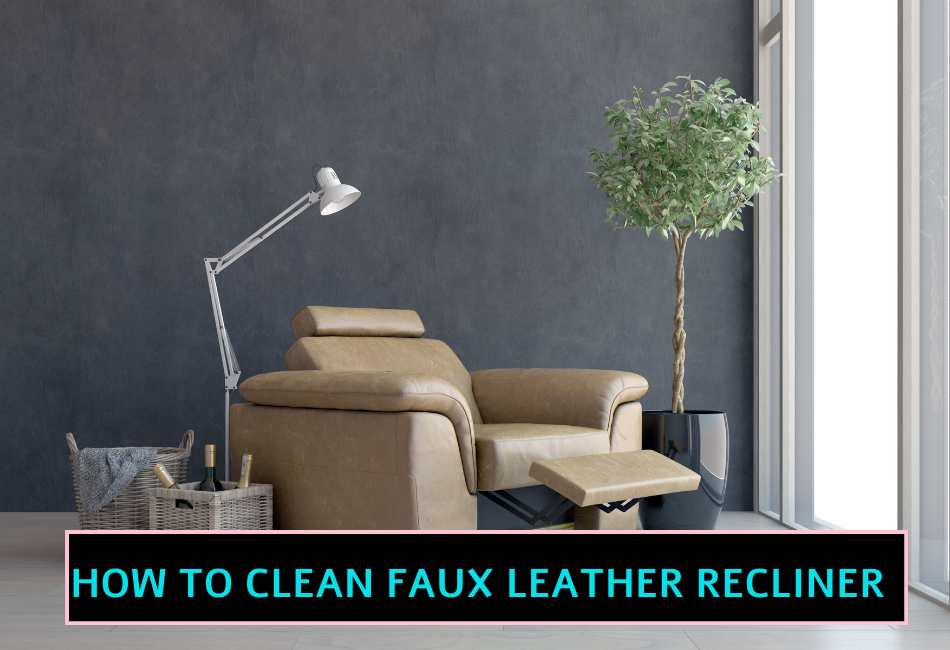Faux leather recliners have skyrocketed in popularity due to their luxurious look, unmatched comfort, and affordability.
As they become a staple in most homes, it’s crucial to understand how to maintain and clean these stylish pieces to ensure their longevity.
Just like any other piece of furniture, faux leather recliners are not immune to collecting dirt or exposure to occasional spills and stains.
The challenges can be many, from dust accumulation to ink stains or spills, but the solutions lie right in your pantry. This guide will divulge five home remedies to keep your faux leather recliner looking as good as new.
Understanding Common Dirt and Stains
Food and Beverage Spills
Confession time: I was once the perpetrator of a major salsa spill on my favorite faux leather recliner. I learned that such spills are common culprits behind stubborn stains.
Crumbs, sauces, and drinks – coffee or wine – can all leave troubling marks. Quick, immediate action is the best approach to prevent permanent staining.
Body Oils and Sweat
Nothing can beat the comfort of lounging on the recliner after a long day at work. However, this comfort comes at a cost. Over time, body oils and sweat can lead to dark patches, especially on the headrest and armrest areas. I regularly wipe down these areas with a cloth to keep the recliner fresh and oil-free.
Ink Stains
I still remember the panic I felt when I found an ink blot on my recliner, courtesy of my adventurous toddler and his love for markers.
Ink stains can be quite daunting, as they have the potential to become permanent. However, the right cleaning solution and method can help rid your recliner of such stubborn stains.
Dust and Dirt Accumulation
Your faux leather recliner might be your favorite relaxation spot, but let me tell you, it’s also a favorite gathering spot for dust and dirt. Regular dusting is a must to prevent build-up that can dull the appearance of your furniture.
Importance of Identifying the Specific Stain for Effective Cleaning
As I’ve discovered over the years, understanding the specific type of stain paves the way for effective cleaning.
Not all stains are the same, and consequently, they require different treatment methods. From salsa spills to dust accumulation, identifying the stain type will help you curate an effective cleaning strategy, ensuring your faux leather recliner remains in its prime condition for years.
Areas Prone to Staining
Your faux leather recliner, much like mine, probably has areas that are more prone to staining than others. Understanding this can help you target your cleaning efforts more efficiently.
Armrests and Headrests
From my experience, armrests and headrests are the most stain-prone areas. Why so, you ask? Therefore, these areas have the highest contact with skin, body oils, and sweat.
Remember that lazy Sunday when I binged my favorite show with a gigantic bowl of cheesy popcorn? Well, the greasy fingerprints left quite a mark on the armrests.
Seat and Back Cushions
Seat and back cushions are next on our list. These areas bear the brunt of accidental food and drink spills.
I cannot count the number of times I’ve jumped off the recliner only to find my coffee cup tipping over and landing right on the seat. The horror!
Footrests and Other Movable Parts
Footrests and other movable parts are not spared either. These areas often come into contact with shoes, collecting grime and dirt.
I remember the time I accidentally rested my muddy boots on the footrest—let’s say it was a good learning experience.
Importance of Targeted Cleaning for Specific Areas
Targeted cleaning based on the stain-prone areas can save you time and effort. For instance, I focus on protecting the armrests and headrests from body oils and sweat using protective covers.
The seat and back cushions get a regular vacuum and wipe down, and the footrests are cleaned thoroughly, especially after a rainy day.
You can keep your faux leather recliner looking pristine for much longer by identifying and targeting the areas most susceptible to staining.
What NOT to Use on Faux Leather Recliners
When it comes to maintaining the pristine look of my beloved faux leather recliner, I’ve learned a thing or two about what not to use. Using the wrong cleaning materials or agents could lead to disastrous results.
Harsh Chemicals that May Damage the Faux Leather
I once made the mistake of using bleach to clean a stubborn stain on the armrest. While it got rid of the stain, it also faded my recliner’s beautiful, dark brown color.
That day, I learned a hard lesson: avoid harsh chemicals like bleach, alcohol, or acetone when cleaning faux leather.
Abrasive Brushes or Scouring Pads that Can Cause Scratches
To remove a hardened piece of gum, I once attacked the seat of my recliner with a stiff-bristled brush. It did the job but left unsightly scratches on the surface.
I realized that abrasive materials like stiff brushes, scouring pads, or even rough cloths can inflict scratches on the soft surface of faux leather.
Excessive Water or Moisture May Lead to Discoloration or Warping
Once, I spilled a whole glass of juice on the seat cushion. In panic, I soaked it in water to dilute the juice. What a disaster that was!
The water not only caused discoloration but also warped the shape of the cushion. Excessive water or moisture, as I discovered, is an absolute no-go for faux leather.
In conclusion, maintaining your faux leather recliner requires careful consideration of the cleaning materials and methods.
Avoid harsh chemicals, abrasive tools, and excessive water in your cleaning routine. With these tips, your faux leather recliner can remain a beloved part of your home decor for years.
Home Remedies for Cleaning Faux Leather Recliners
1. Mild Soap and Water Solution
The first homemade remedy I found effective in cleaning my faux leather recliner is a simple solution of mild soap and water.
This combination has proven to be a safe and efficient cleaner for faux leather. The proper mixing ratio I generally use is one part soap to ten parts water.
To apply, I soak a soft cloth in the solution and wring out the excess – you want it damp, not dripping. Then I gently scrub the stained or dirty areas of the recliner.
The key word here is gentle. Too much pressure can lead to scratches or discoloration. I learned that the hard way when I scrubbed a bit too zealous and left a noticeable mark.
After scrubbing, I wipe the area with a clean, dry cloth to prevent moisture damage. Trust me, faux leather and excess water don’t get along!
2. White Vinegar and Water Mixture
Another home remedy that has worked miracles for me is a mixture of white vinegar and water.
White vinegar, it turns out, is not just for salads; it’s a great stain remover too. I spilled a cup of coffee on my recliner once, and this mixture saved the day!
The dilution ratio I use is equal parts vinegar and water. Like the soap and water solution, I apply this mixture using a soft, damp cloth and gently wipe the stained area.
Patience is key here – I learned not to rush when I frantically tried to remove a stubborn red wine stain and nearly ruined my recliner.
After a thorough but gentle wipe, I dry the area with a clean cloth to remove any remaining vinegar smell and prevent moisture build-up.
So there you have it, two easy, affordable, and effective home remedies for maintaining your faux leather recliners.
Cleaning doesn’t have to be a nightmare, even when faced with stubborn stains. Remember, gentle is the way to go!
3. Baking Soda Paste
A hidden gem in the world of spot cleaning is, believe it or not, baking soda! It’s great for absorbing oil and grease stains that can be a real headache.
- Creation of the Paste
To make the paste, I mix equal parts baking soda and water in a small bowl – just enough to create a thick, spreadable paste.
I recall a time when I mistakenly added too much water, turning it into a runny mess. That’s a mistake you don’t want to make!
- Application on Stains
After concocting my paste, I apply it directly onto the stain. I remember the first time I tried this hack on an oil stain I thought would never disappear. I could hardly contain my excitement as I spooned the paste onto the recliner.
- Gentle Rubbing Technique
Using a soft cloth, I gently rub the paste into the stain. It’s important – as I’ve learned the hard way – not to scrub too hard, or you could risk damaging the faux leather. After a gentle rub, I let the paste sit for a few minutes to do its magic.
4. Commercial Leather Cleaner
When home remedies don’t do the trick, there are always commercial cleaners. They’re designed specifically for faux leather and can give your recliner a new lease on life.
- Selection of a Suitable Cleaner
Choosing the right cleaner can be daunting with so many options on the market. I’ve tried several times and found that reading reviews and labels carefully helps me pick the one that suits my needs.
- Application Instructions
Once I’ve chosen my cleaner, I diligently follow the instructions on the label. Most of these cleaners require a small amount to be applied onto a soft cloth which is then used to wipe the recliner.
I still remember the first time I used a commercial cleaner, I was amazed at how little I needed to do the job.
- Wiping and Drying Process
After cleaning, I wipe off any excess cleaner and dry the area with a clean cloth. This step is critical to prevent any residue or moisture damage. My recliner is my pride and joy; it is worth all the effort to see it clean and shiny!
And there you have it! From baking soda paste to commercial cleaners, maintaining your faux leather recliner doesn’t have to be daunting.
Always be gentle with your cleaning; your faux leather will thank you!
5. Olive Oil and Lemon Juice Mixture
One day, while browsing the internet, I stumbled upon a DIY mixture that surprised me – the olive oil and lemon juice mixture. I was initially skeptical, but it became a game-changer for me.
- Preparation
This magic concoction is relatively simple to prepare. All it takes is a 2:1 ratio of olive oil to lemon juice. I usually mix two tablespoons of olive oil with one tablespoon of lemon juice in a small bowl.
- Application for Conditioning and Stain Removal
Once my mixture is ready, I apply it to my faux leather recliner using a soft cloth. What amazed me was its conditioning properties and its power to remove some of the stubborn stains. I gently rub the mixture in, ensuring it does not scrub too hard.
- Buffing for Shine
After allowing the mixture to sit for a few minutes, I buff the surface using a clean, dry cloth. The result?
A lustrous shine that gives my recliner a refreshed look! I remember standing back and just admiring the glow on my chair.
Conclusion
Maintaining your faux leather recliner is about keeping it clean, preserving its aesthetic appeal, and extending its lifespan.
Throughout this article, I’ve shared various methods, from the humble baking soda paste to the DIY olive oil and lemon juice mixture, each with unique strengths.
Like me, you’ll find that taking care of your recliner can be simple and satisfying.
Regular cleaning is key to keeping your faux leather in top condition. So why wait? Roll up your sleeves and give your recliner the love it deserves!


